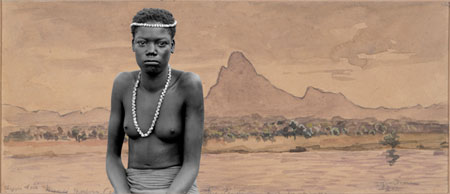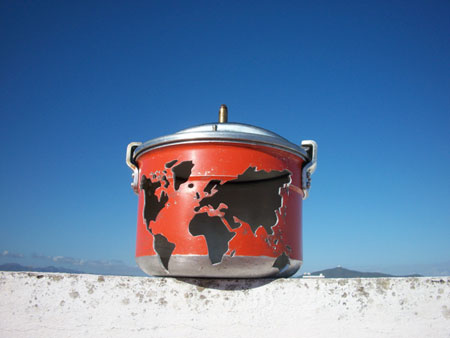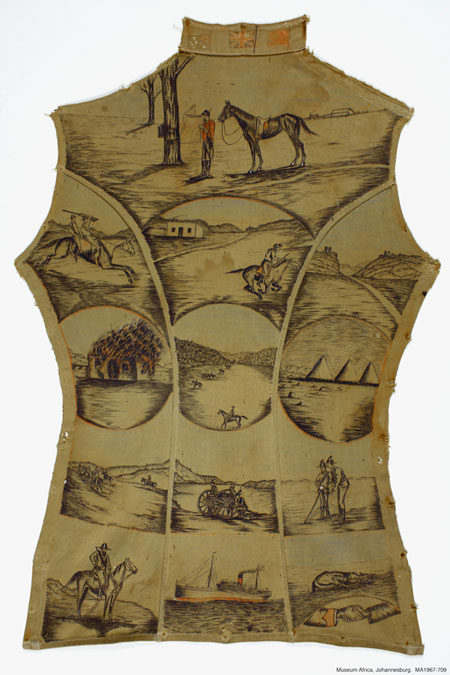|

The earth's mountains, deserts, and grassy meadows have helped tell stories of the exotic, individual and collective identity, desire, and trauma. Never neutral, interpretations of a landscape can change over time or according to location. Once, a sun-kissed landscape represented the hopes and ambitions associated with frontiers; over time, however, the earth's open spaces have also become symbols of abandonment, or even desecration. For someone who has moved far away from the land of his or her birth, a landscape might symbolize what has been left behind-or what is sought. In similar fashion, maps tell us where we want to go and what we want to record. Maps, and landscape painting and photography, represent strategies by which individuals and communities have interpreted and set priorities for the earth's changing surface. Sculpture and performance arts have also served to demarcate grass fields and forest areas alike, sometimes setting aside space for the ancestors, at other times marking the differences between the domestic and wild.
|

Sammy Baloji
b. 1978, Democratic Republic of the Congo
Portrait # 2: Femme Urua sur fond d'aquarelle de Dardenne [Luba woman against watercolor by Dardenne]
From the series Congo Far West: Retracing Charles Lemaire's Expedition
2011
Digital photograph on matte Hahnemuhle paper
Collection of the artist, courtesy Axis Gallery, New York and New Jersey
Rethinking the landscape. While at the Belgium's Royal Museum of Central Africa, Sammy Baloji researched and created new work based on the archival documents of an 1898-1900 colonial expedition to Baloji's home region of Katanga in the Democratic Republic of the Congo. Baloji was intrigued by the "different modes of representing reality" by two men on the expedition: the taxidermist and photographer François Michel, and the painter Leon Dardenne. He enlarged and isolated Michel's photograph of an unnamed Luba woman and layered it over a romantic and unpopulated watercolor by Dardenne. In so doing, he confronts us with what is missing from both portrait and landscape and the encounters that produced them.
|
Mbuti artist, Ituri forest, Democratic Republic of the Congo
Painted bark cloth
Mid-20th century
Bark, pigment
Felix Collection
Mapping life in the forest. Charles Hénault, a Belgian jazz drummer who acquired approximately 100 Mbuti bark cloths in the 1970s, reported that the drawings on this cloth represented waterways, forest clearings, hunting areas, and camps. Its arrangement of cross-hatched and filled chevrons could easily suggest clearings or domesticated space. Mbuti men and women particularly cherished works in which the artist incorporated voids within their patterns.
|
Allan deSouza
b. 1958, Kenya
from top to bottom
Divine2055, Divine6046, Divine1881
2008
Chromogenic prints
Courtesy Talwar Gallery, New York/New Delhi
Landscape and fantasy. A frequent traveler, Allan deSouza likes the window seat. The Divine series pairs landscapes photographed out of airplane windows with their mirror images. According to the artist, the new composites suggest "divine-like manifestations, whether human-made shrines, mythological figures, aliens [or] other figures of the social imagination." The resulting faces, birds, and majestic scenes reveal the fantasies we can still read into the landscape.
|

Batoul S'himi
b. 1974, Morocco
Untitled, from the series World Under Pressure
2011
Aluminum
Collection of the artist, courtesy Rose Issa Projects, London
Putting women on the map. Batoul S'himi has converted a pressure cooker into an ambassador that can travel the globe and assert the artist's place, and the place of women, in it. At once quirky and eloquent, the sculpture takes the most domestic and local of spaces-the kitchen or hearth-and situates it within a global picture. S'himi's selection of a pressure cooker draws attention to the underwhelming representation of women and women's issues on a global level, while also slyly alluding to the mounting pressure to change this.
|

Artist unknown (Soldier)
Untitled (war scenes drawn on tunic)
c. 1902
Black ink and paint on textile
Museum Africa, Johannesburg, South Africa MA 1967-709
Wearing the landscape. Soldiers brave the elements, sometimes with nothing but their uniforms to protect them. One such soldier from South Africa's Anglo-Boer War drew stories of war on the uniform that protected him from the elements and proclaimed his participation in the battle for control of South Africa's contested land.
|

Luba artist, Democratic Republic of the Congo
Lukasa (mapping and memory board)
Before 1884
Wood
National Museum of Natural History, Smithsonian Institution, Department of Anthropology, Collection of Herbert Ward, gift of Mrs. Sarita Ward, no. E323440
Mapping memory. Five heads emerge like islands or termite hills from a surface carved with concentric circles that radiate like rippling water. The moundlike heads most likely refer to places of memory-physical and metaphorical landmarks that help maintain a record of Luba history and the relationships between Luba leaders and the territories of the Luba state.
|
|
|





